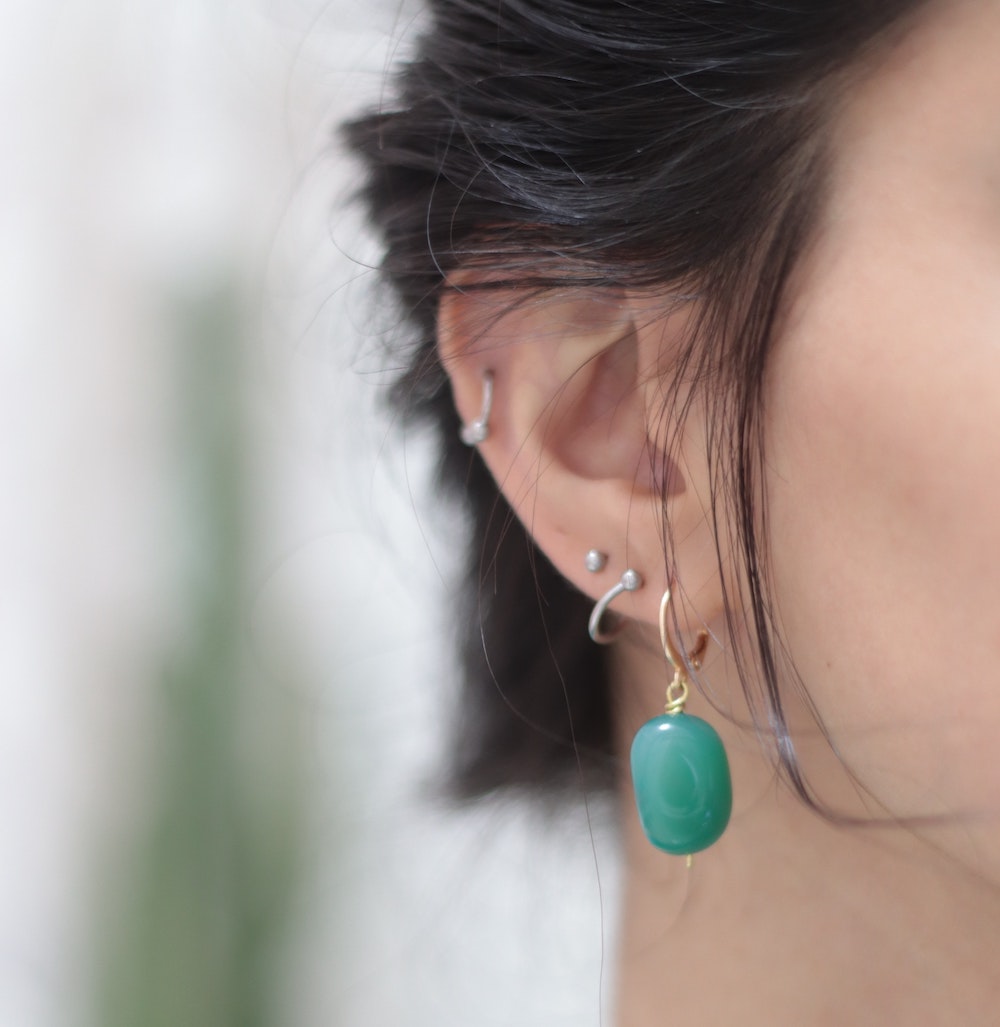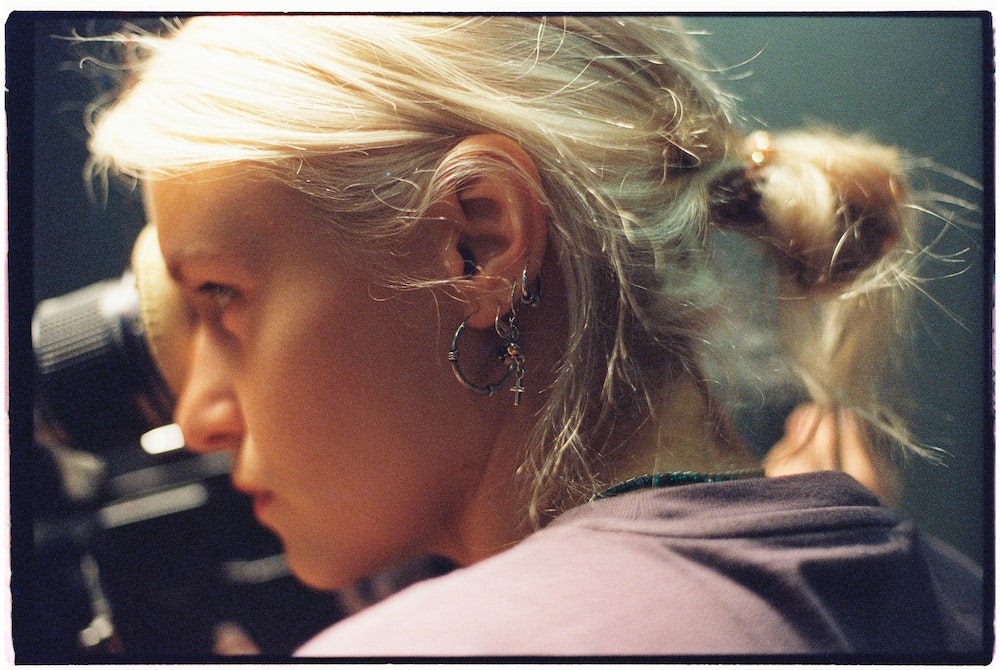The Lobe Piercing: A Guide to the Most Common Piercing April 22, 2021 – Posted in: Piercing Advice, Piercing Types – Tags: ear lobe piercing, ear piercing, ear piercing care, ear piercing healing time, lobe piercing, lobe piercing care, lobe piercing healing time, piercing aftercare
Lobe piercing highlights:
- Clean your new ear piercing 2 – 3 times daily with a piercing aftercare saline solution for the entire healing period.
- The lobe begs for unique placement. Don’t be afraid to get creative.
- Upper lobe piercings can offer a great alternative to cartilage piercing styles.
In the piercing world, it’s easy to get distracted by all of the trendy, interesting piercings out there and forget about one of the basics: the lobe piercing.
By far the most popular piercing, the lobe piercing is officially part of mainstream fashion. But, because of its popularity, it’s easy to forget that it, like every other piercing, requires proper care even after it has healed.
The lobe can also be an exciting canvas. Besides the single and double-lobe piercings, you can have a lot of fun and get creative with the placement of multiple-lobe piercings.
Here’s a quick guide to the lobe piercing and some ideas to help your lobe piercing stand out.
Lobe Piercing Fast Facts
- Healing time: Around 6 – 8 weeks
- Pain level: Low
- Jewelry: Hoops, straight posts, dangles, circular barbells, and more
Lobe piercing aftercare

Photo by LynDa MouTcha
The lobe piercing is perhaps one of the easier piercings to heal since it only takes around 6 weeks. However, that doesn’t mean that you can get lazy with aftercare practices.
Along with cleaning your piercing 2 – 3 times daily with a piercing aftercare saline solution, you should pay attention to the following.
- Try not to sleep on your piercing as it heals.
- Stay away from standing water (like swimming pools, lakes, and baths).
- Don’t touch the piercing.
- Keep the jewelry still. Do not twist the jewelry within the piercing.
- Have a piercer confirm that the lobe has fully healed before stopping aftercare practices.
You should also care for your piercing after it heals. Dead skin cells will build up in your piercing tunnel, so you should clean your piercing every once in a while to clear out the buildup. You should clean your jewelry every few months, too. Piercings tend to get a bit of a smell if left alone, and cleaning your jewelry can help prevent that. It will also keep your jewelry bright and shining for longer.
Buy NeilMed piercing aftercare here.
Are there any risks?
As with any piercing, there are some risks. However, compared to other piercing types, the risks associated with the lobe piercing are actually quite low. This is partially due to the fast healing time; many risks associated with piercings appear due to the prolonged time that the piercing is in a delicate state. That being said, you must still practice the same cautions as any other piercing to ensure that your lobe piercing heals safely. Here are some risks and how to avoid them.
- Damage during piercing from improper practices. This includes the use of a piercing gun. For any piercing, including a lobe piercing, a piercing gun should be avoided at all costs as it is an unsafe tool. Set your piercing up for success by heading to a reputable piercer who uses needles.
- Infection. While it is relatively rare to see a full, serious piercing infection, it does happen, so you must be aware. Make sure that you clean your piercing daily, avoid standing water, like that in pools or bathtubs, and refrain from touching your piercing as much as possible as it heals. Learn more about piercing infections here.
- Bad snags or tears. In the recent past, 24G was the recommended thickness for lobe piercing jewelry. However, while this ultra-thin jewelry is dainty, it can also pose a tear risk. Because the jewelry is so thin, it can easily rip through the skin. Now, piercers prefer a thicker 20G or 18G. You should also be aware of your surroundings, and don’t wear dangle jewelry around children or while participating in certain activities.

Photo by Yaroslava Borz
Ear piercing styles
Many people don’t realize how creative you can get when it comes to your lobe piercings. If you’re interested in multiple lobe piercings, have some fun planning out a unique design. Depending on the size of your lobe, you can stack multiple lobe piercings on top of each other, conduct three piercings in a triangular shape, or even come up with a design of your own.
The only stipulation is the size of your lobe. You need enough space to conduct each piercing safely.
Another popular style is to plan multiple lobe piercings combined with cartilage piercings for a cohesive ear piercing look. You can sport an entire row of piercings along the rim of the ear, or you can even create a meaningful picture with your ear piercings.
Upper lobe piercings appear in the fleshier tissue near the cartilage in the upper portion of the ear lobe. This can be a fantastic option for those who desire a cartilage piercing look but don’t want to go through the 6 – 9 month healing period.
A common trend is constellation piercings. These piercings represent a specific star sign. Many choose the star sign associated with their birth, but you can choose any constellation that means something to you. They vary depending on your anatomy, so those interested in this style might get a consultation with a piercer in order to safely design their constellation look.
Just because the earlobe is a common piercing location doesn’t mean that it deserves any less love. There’s a reason why so many people choose to get their lobes pierced; it’s a classic, stunning look that is fairly easy to take care of.
Whether you’re getting your lobes pierced for the first time, or you’re adding to your lobe piercing look, don’t forget proper aftercare, both while your piercing is healing and afterward. The key to successful piercings is proper care, and lobe piercings are no different.











